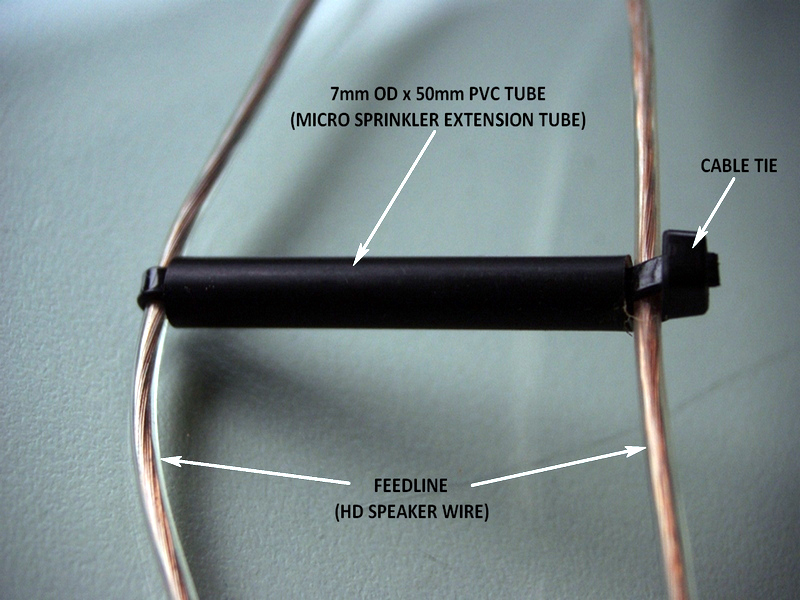Parallel Circular Conductor Transmission Line Calculator
Serge Y. Stroobandt, ON4AA
Copyright 2015–2020, licensed under Creative Commons BY-NC-SA
- Home
- Parallel Circular Conductor TL
Introduction
This calculator is a tool for designing balanced transmission lines with a specific desired characteristic impedance \(Z_\text{c}\) and made of parallel circular conductors of a given diameter \(d\). Round open wire Lecher line, ladder or window line and twin‑lead line are all balanced transmission lines which are frequently encountered as the feed line of severely mismatched multi-band wire antennas, especially the G5RV antenna. The conductors being massive or hollow does not affect the characteristic impedance.

Parallel circular conductor transmission line; dimensions.
Construction
Here is an excellent construction suggestion by Leon Salden, VK3VGA. He devised a ladder line spreader built from durable and readily available materials; a black cable tie and black polyethylene (PE) irrigation extension tube. For smaller separation distances, black LED spacers can also be used.

Ladder line spreader built from black irrigation extension tube and a cable tie. Source: Leon Salden, VK3VGA
Formulas
Following formula can be derived for the characteristic impedance of a parallel wire transmission line:1
\[Z_\text{c} = \frac{Z_0}{\pi\sqrt{\epsilon_\text{r}}}\;\text{acosh}\left(\frac{D}{d}\right)\](1)
The characteristic impedance of free space is exactly:
\[Z_0 = \sqrt{\frac{\mu_0}{\epsilon_0}} = \mu_0\cdot c_0 \approx 376.73\,\Omega\]
\(c_0 = 299\,792\,458\,\frac{\text{m}}{\text{s}}\): the speed of light in free space
\(\mu_0 = 4\pi\cdot10^{-7}\frac{\text{H}}{\text{m}}\): the free space permeability
\(\epsilon_0 = \frac{1}{\mu_0 c_0^2}\): the absolute permittivity of free space
\(Z_0\): the characteristic impedance of free space
Rearranging and solving Eq. 1 for \(D\):
\[D = d\cdot\cosh{\left(\pi\frac{Z_\text{c}}{Z_0}\sqrt{\epsilon_\text{r}}\right)}\]
\[s = D - d\]
\(D\): the centre to centre distance
\(d\): the diameter of the circular conductors
\(Z_\text{c}\): the desired characteristic impedance of the transmission line
\(Z_0\): the characteristic impedance of free space
\(\epsilon_\text{r}\): the relative dielectric constant of the surrounding medium (1.00054 for air)
\(s\): the space between the circular conductors
Brython source code
Here is the Brython code of this calculator. Brython code is not intended for running stand alone, even though it looks almost identical to Python 3. Brython code runs on the client side in the browser, where it is transcoded to secure Javascript.
Measuring characteristic impedance
The characteristic impedance of a transmission line can easily be determined from two vector network analyser (VNA) measurements. This is explained in detail here.
References

This work is licensed under a Creative Commons Attribution‑NonCommercial‑ShareAlike 4.0 International License.
Other licensing available on request.

Unless otherwise stated, all originally authored software on this site is licensed under the terms of GNU GPL version 3.
This static web site has no backend database.
Hence, no personal data is collected and GDPR compliance is met.
Moreover, this domain does not set any first party cookies.
All Google ads shown on this web site are, irrespective of your location,
restricted in data processing to meet compliance with the CCPA and GDPR.
However, Google AdSense may set third party cookies for traffic analysis and
use JavaScript to obtain a unique set of browser data.
Your browser can be configured to block third party cookies.
Furthermore, installing an ad blocker like EFF's Privacy Badger
will block the JavaScript of ads.
Google's ad policies can be found here.
transcoded by
 .
.


